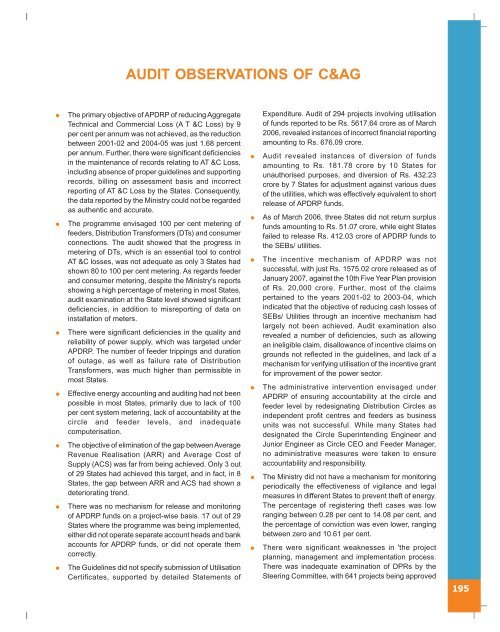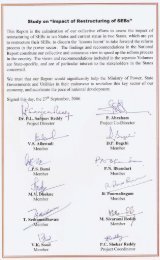MoP - Ministry of Power
MoP - Ministry of Power
MoP - Ministry of Power
You also want an ePaper? Increase the reach of your titles
YUMPU automatically turns print PDFs into web optimized ePapers that Google loves.
AUDIT OBSERVATIONS OF C&AG<br />
The primary objective <strong>of</strong> APDRP <strong>of</strong> reducing Aggregate<br />
Technical and Commercial Loss (A T &C Loss) by 9<br />
per cent per annum was not achieved, as the reduction<br />
between 2001-02 and 2004-05 was just 1.68 percent<br />
per annum. Further, there were significant deficiencies<br />
in the maintenance <strong>of</strong> records relating to AT &C Loss,<br />
including absence <strong>of</strong> proper guidelines and supporting<br />
records, billing on assessment basis and incorrect<br />
reporting <strong>of</strong> AT &C Loss by the States. Consequently,<br />
the data reported by the <strong>Ministry</strong> could not be regarded<br />
as authentic and accurate.<br />
The programme envisaged 100 per cent metering <strong>of</strong><br />
feeders, Distribution Transformers (DTs) and consumer<br />
connections. The audit showed that the progress in<br />
metering <strong>of</strong> DTs, which is an essential tool to control<br />
AT &C losses, was not adequate as only 3 States had<br />
shown 80 to 100 per cent metering. As regards feeder<br />
and consumer metering, despite the <strong>Ministry</strong>'s reports<br />
showing a high percentage <strong>of</strong> metering in most States,<br />
audit examination at the State level showed significant<br />
deficiencies, in addition to misreporting <strong>of</strong> data on<br />
installation <strong>of</strong> meters.<br />
There were significant deficiencies in the quality and<br />
reliability <strong>of</strong> power supply, which was targeted under<br />
APDRP. The number <strong>of</strong> feeder trippings and duration<br />
<strong>of</strong> outage, as well as failure rate <strong>of</strong> Distribution<br />
Transformers, was much higher than permissible in<br />
most States.<br />
Effective energy accounting and auditing had not been<br />
possible in most States, primarily due to lack <strong>of</strong> 100<br />
per cent system metering, lack <strong>of</strong> accountability at the<br />
circle and feeder levels, and inadequate<br />
computerisation.<br />
The objective <strong>of</strong> elimination <strong>of</strong> the gap between Average<br />
Revenue Realisation (ARR) and Average Cost <strong>of</strong><br />
Supply (ACS) was far from being achieved. Only 3 out<br />
<strong>of</strong> 29 States had achieved this target, and in fact, in 8<br />
States, the gap between ARR and ACS had shown a<br />
deteriorating trend.<br />
There was no mechanism for release and monitoring<br />
<strong>of</strong> APDRP funds on a project-wise basis. 17 out <strong>of</strong> 29<br />
States where the programme was being implemented,<br />
either did not operate separate account heads and bank<br />
accounts for APDRP funds, or did not operate them<br />
correctly.<br />
The Guidelines did not specify submission <strong>of</strong> Utilisation<br />
Certificates, supported by detailed Statements <strong>of</strong><br />
Expenditure. Audit <strong>of</strong> 294 projects involving utilisation<br />
<strong>of</strong> funds reported to be Rs. 5617.64 crore as <strong>of</strong> March<br />
2006, revealed instances <strong>of</strong> incorrect financial reporting<br />
amounting to Rs. 676.09 crore.<br />
Audit revealed instances <strong>of</strong> diversion <strong>of</strong> funds<br />
amounting to Rs. 181.78 crore by 10 States for<br />
unauthorised purposes, and diversion <strong>of</strong> Rs. 432.23<br />
crore by 7 States for adjustment against various dues<br />
<strong>of</strong> the utilities, which was effectively equivalent to short<br />
release <strong>of</strong> APDRP funds.<br />
As <strong>of</strong> March 2006, three States did not return surplus<br />
funds amounting to Rs. 51.07 crore, while eight States<br />
failed to release Rs. 412.03 crore <strong>of</strong> APDRP funds to<br />
the SEBs/ utilities.<br />
The incentive mechanism <strong>of</strong> APDRP was not<br />
successful, with just Rs. 1575.02 crore released as <strong>of</strong><br />
January 2007, against the 10th Five Year Plan provision<br />
<strong>of</strong> Rs. 20,000 crore. Further, most <strong>of</strong> the claims<br />
pertained to the years 2001-02 to 2003-04, which<br />
indicated that the objective <strong>of</strong> reducing cash losses <strong>of</strong><br />
SEBs/ Utilities through an incentive mechanism had<br />
largely not been achieved. Audit examination also<br />
revealed a number <strong>of</strong> deficiencies, such as allowing<br />
an ineligible claim, disallowance <strong>of</strong> incentive claims on<br />
grounds not reflected in the guidelines, and lack <strong>of</strong> a<br />
mechanism for verifying utilisation <strong>of</strong> the incentive grant<br />
for improvement <strong>of</strong> the power sector.<br />
The administrative intervention envisaged under<br />
APDRP <strong>of</strong> ensuring accountability at the circle and<br />
feeder level by redesignating Distribution Circles as<br />
independent pr<strong>of</strong>it centres and feeders as business<br />
units was not successful. While many States had<br />
designated the Circle Superintending Engineer and<br />
Junior Engineer as Circle CEO and Feeder Manager,<br />
no administrative measures were taken to ensure<br />
accountability and responsibility.<br />
The <strong>Ministry</strong> did not have a mechanism for monitoring<br />
periodically the effectiveness <strong>of</strong> vigilance and legal<br />
measures in different States to prevent theft <strong>of</strong> energy.<br />
The percentage <strong>of</strong> registering theft cases was low<br />
ranging between 0.28 per cent to 14.08 per cent, and<br />
the percentage <strong>of</strong> conviction was even lower, ranging<br />
between zero and 10.61 per cent.<br />
There were significant weaknesses in 'the project<br />
planning, management and implementation process.<br />
There was inadequate examination <strong>of</strong> DPRs by the<br />
Steering Committee, with 641 projects being approved<br />
195

















